Supply Chain Management Analysis Project in Myanmar
VerifiedAdded on 2020/04/21
|71
|20533
|482
Project
AI Summary
This project is a comprehensive analysis of supply chain management (SCM) within the furniture industry in Myanmar. It begins with an introduction to SCM, its evolution, and key elements, followed by a literature review that defines SCM, explores its processes, and examines the current situation of the furniture industry in Myanmar, including competitive advantages and challenges. The research methodology chapter details the research ontology, approach, design, and strategy, including data collection methods and sampling techniques. The results and discussion chapter presents demographic profiles, response rates, and comparisons of collected data. The study concludes with findings, limitations, and recommendations for future research and general improvements to SCM practices within the industry. The project aims to provide insights into optimizing supply chain processes and enhancing the competitiveness of furniture businesses in Myanmar.
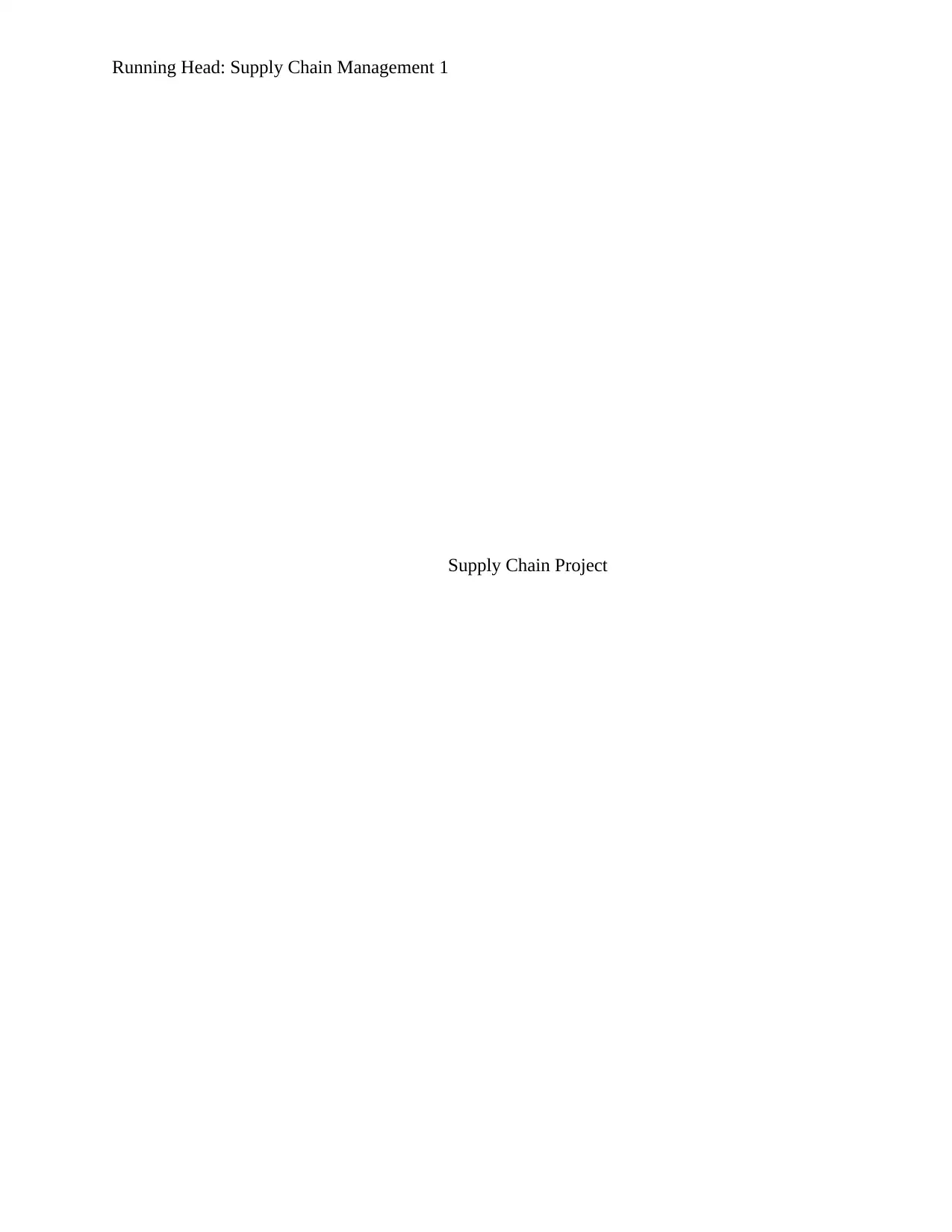
Running Head: Supply Chain Management 1
Supply Chain Project
Supply Chain Project
Paraphrase This Document
Need a fresh take? Get an instant paraphrase of this document with our AI Paraphraser
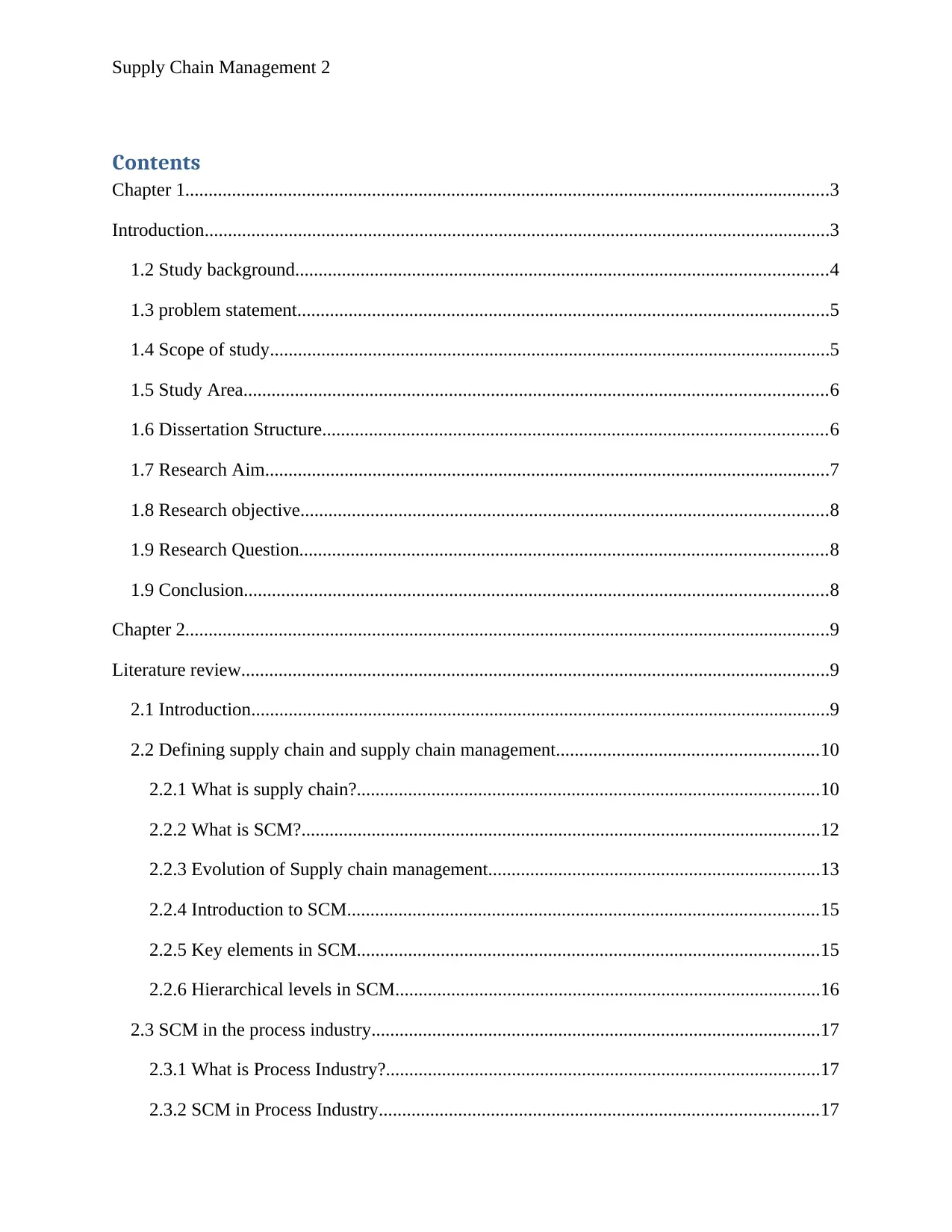
Supply Chain Management 2
Contents
Chapter 1..........................................................................................................................................3
Introduction......................................................................................................................................3
1.2 Study background..................................................................................................................4
1.3 problem statement..................................................................................................................5
1.4 Scope of study........................................................................................................................5
1.5 Study Area.............................................................................................................................6
1.6 Dissertation Structure............................................................................................................6
1.7 Research Aim.........................................................................................................................7
1.8 Research objective.................................................................................................................8
1.9 Research Question.................................................................................................................8
1.9 Conclusion.............................................................................................................................8
Chapter 2..........................................................................................................................................9
Literature review..............................................................................................................................9
2.1 Introduction............................................................................................................................9
2.2 Defining supply chain and supply chain management........................................................10
2.2.1 What is supply chain?...................................................................................................10
2.2.2 What is SCM?...............................................................................................................12
2.2.3 Evolution of Supply chain management.......................................................................13
2.2.4 Introduction to SCM.....................................................................................................15
2.2.5 Key elements in SCM...................................................................................................15
2.2.6 Hierarchical levels in SCM...........................................................................................16
2.3 SCM in the process industry................................................................................................17
2.3.1 What is Process Industry?.............................................................................................17
2.3.2 SCM in Process Industry..............................................................................................17
Contents
Chapter 1..........................................................................................................................................3
Introduction......................................................................................................................................3
1.2 Study background..................................................................................................................4
1.3 problem statement..................................................................................................................5
1.4 Scope of study........................................................................................................................5
1.5 Study Area.............................................................................................................................6
1.6 Dissertation Structure............................................................................................................6
1.7 Research Aim.........................................................................................................................7
1.8 Research objective.................................................................................................................8
1.9 Research Question.................................................................................................................8
1.9 Conclusion.............................................................................................................................8
Chapter 2..........................................................................................................................................9
Literature review..............................................................................................................................9
2.1 Introduction............................................................................................................................9
2.2 Defining supply chain and supply chain management........................................................10
2.2.1 What is supply chain?...................................................................................................10
2.2.2 What is SCM?...............................................................................................................12
2.2.3 Evolution of Supply chain management.......................................................................13
2.2.4 Introduction to SCM.....................................................................................................15
2.2.5 Key elements in SCM...................................................................................................15
2.2.6 Hierarchical levels in SCM...........................................................................................16
2.3 SCM in the process industry................................................................................................17
2.3.1 What is Process Industry?.............................................................................................17
2.3.2 SCM in Process Industry..............................................................................................17
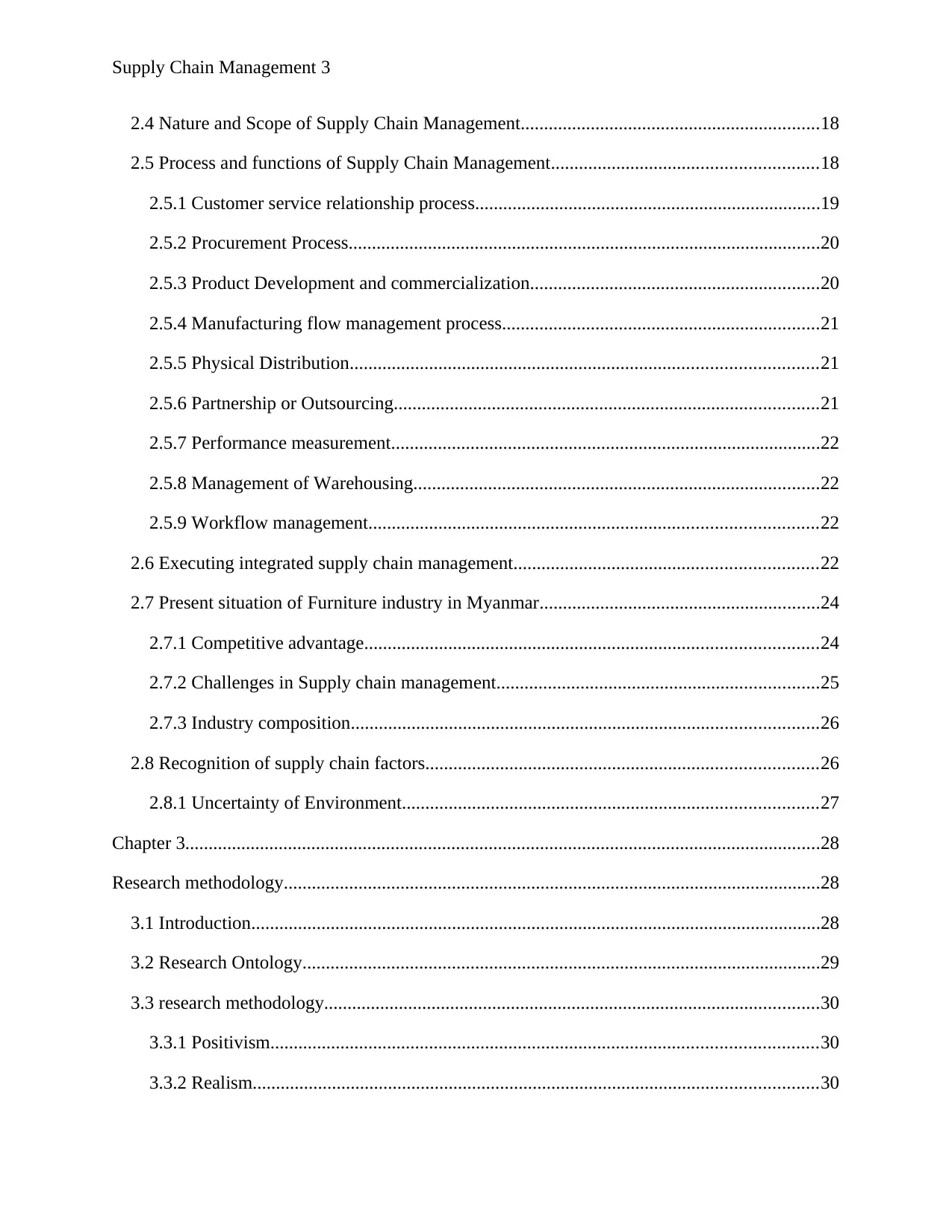
Supply Chain Management 3
2.4 Nature and Scope of Supply Chain Management................................................................18
2.5 Process and functions of Supply Chain Management.........................................................18
2.5.1 Customer service relationship process..........................................................................19
2.5.2 Procurement Process.....................................................................................................20
2.5.3 Product Development and commercialization..............................................................20
2.5.4 Manufacturing flow management process....................................................................21
2.5.5 Physical Distribution....................................................................................................21
2.5.6 Partnership or Outsourcing...........................................................................................21
2.5.7 Performance measurement............................................................................................22
2.5.8 Management of Warehousing.......................................................................................22
2.5.9 Workflow management................................................................................................22
2.6 Executing integrated supply chain management.................................................................22
2.7 Present situation of Furniture industry in Myanmar............................................................24
2.7.1 Competitive advantage.................................................................................................24
2.7.2 Challenges in Supply chain management.....................................................................25
2.7.3 Industry composition....................................................................................................26
2.8 Recognition of supply chain factors....................................................................................26
2.8.1 Uncertainty of Environment.........................................................................................27
Chapter 3........................................................................................................................................28
Research methodology...................................................................................................................28
3.1 Introduction..........................................................................................................................28
3.2 Research Ontology...............................................................................................................29
3.3 research methodology..........................................................................................................30
3.3.1 Positivism.....................................................................................................................30
3.3.2 Realism.........................................................................................................................30
2.4 Nature and Scope of Supply Chain Management................................................................18
2.5 Process and functions of Supply Chain Management.........................................................18
2.5.1 Customer service relationship process..........................................................................19
2.5.2 Procurement Process.....................................................................................................20
2.5.3 Product Development and commercialization..............................................................20
2.5.4 Manufacturing flow management process....................................................................21
2.5.5 Physical Distribution....................................................................................................21
2.5.6 Partnership or Outsourcing...........................................................................................21
2.5.7 Performance measurement............................................................................................22
2.5.8 Management of Warehousing.......................................................................................22
2.5.9 Workflow management................................................................................................22
2.6 Executing integrated supply chain management.................................................................22
2.7 Present situation of Furniture industry in Myanmar............................................................24
2.7.1 Competitive advantage.................................................................................................24
2.7.2 Challenges in Supply chain management.....................................................................25
2.7.3 Industry composition....................................................................................................26
2.8 Recognition of supply chain factors....................................................................................26
2.8.1 Uncertainty of Environment.........................................................................................27
Chapter 3........................................................................................................................................28
Research methodology...................................................................................................................28
3.1 Introduction..........................................................................................................................28
3.2 Research Ontology...............................................................................................................29
3.3 research methodology..........................................................................................................30
3.3.1 Positivism.....................................................................................................................30
3.3.2 Realism.........................................................................................................................30
⊘ This is a preview!⊘
Do you want full access?
Subscribe today to unlock all pages.

Trusted by 1+ million students worldwide
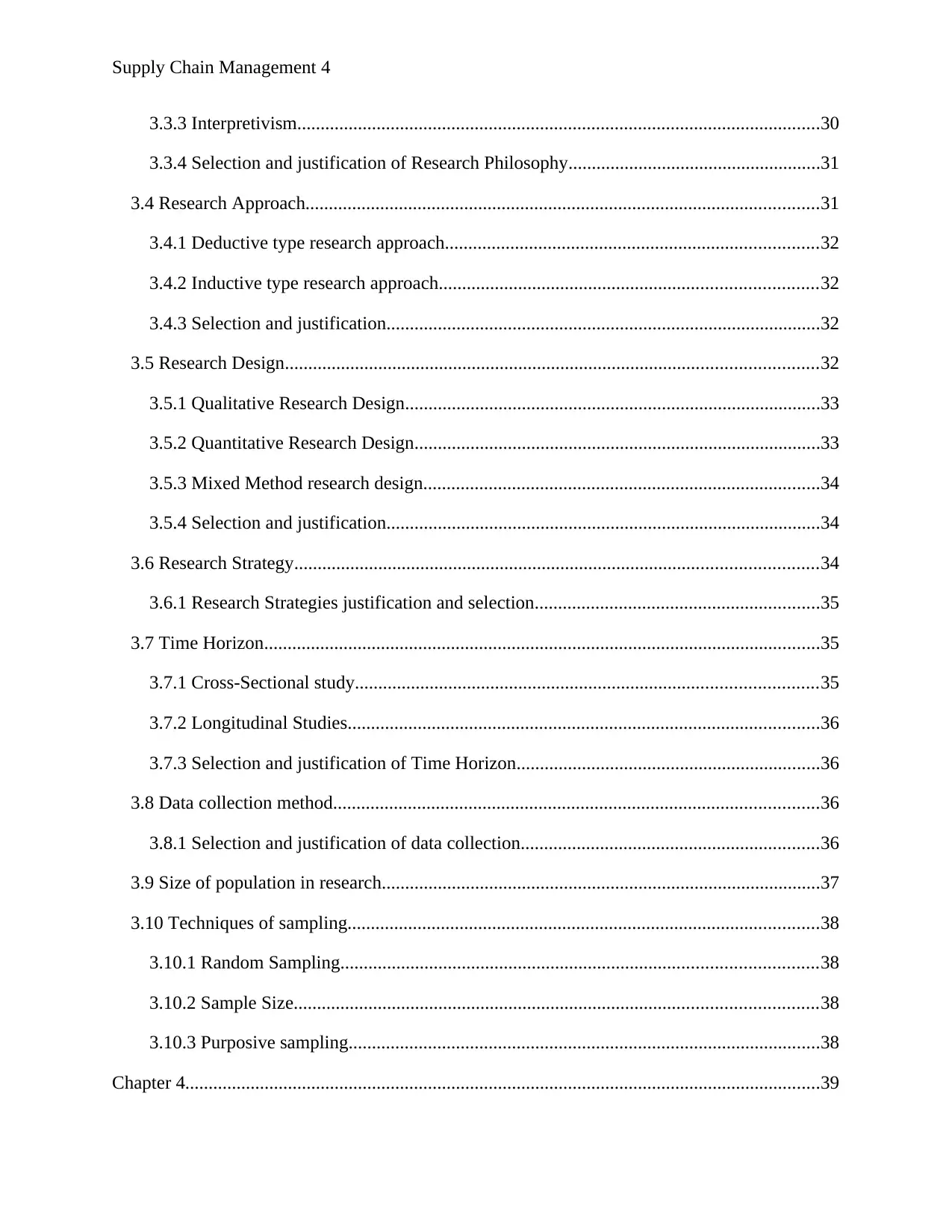
Supply Chain Management 4
3.3.3 Interpretivism................................................................................................................30
3.3.4 Selection and justification of Research Philosophy......................................................31
3.4 Research Approach..............................................................................................................31
3.4.1 Deductive type research approach................................................................................32
3.4.2 Inductive type research approach.................................................................................32
3.4.3 Selection and justification.............................................................................................32
3.5 Research Design..................................................................................................................32
3.5.1 Qualitative Research Design.........................................................................................33
3.5.2 Quantitative Research Design.......................................................................................33
3.5.3 Mixed Method research design.....................................................................................34
3.5.4 Selection and justification.............................................................................................34
3.6 Research Strategy................................................................................................................34
3.6.1 Research Strategies justification and selection.............................................................35
3.7 Time Horizon.......................................................................................................................35
3.7.1 Cross-Sectional study...................................................................................................35
3.7.2 Longitudinal Studies.....................................................................................................36
3.7.3 Selection and justification of Time Horizon.................................................................36
3.8 Data collection method........................................................................................................36
3.8.1 Selection and justification of data collection................................................................36
3.9 Size of population in research..............................................................................................37
3.10 Techniques of sampling.....................................................................................................38
3.10.1 Random Sampling......................................................................................................38
3.10.2 Sample Size................................................................................................................38
3.10.3 Purposive sampling.....................................................................................................38
Chapter 4........................................................................................................................................39
3.3.3 Interpretivism................................................................................................................30
3.3.4 Selection and justification of Research Philosophy......................................................31
3.4 Research Approach..............................................................................................................31
3.4.1 Deductive type research approach................................................................................32
3.4.2 Inductive type research approach.................................................................................32
3.4.3 Selection and justification.............................................................................................32
3.5 Research Design..................................................................................................................32
3.5.1 Qualitative Research Design.........................................................................................33
3.5.2 Quantitative Research Design.......................................................................................33
3.5.3 Mixed Method research design.....................................................................................34
3.5.4 Selection and justification.............................................................................................34
3.6 Research Strategy................................................................................................................34
3.6.1 Research Strategies justification and selection.............................................................35
3.7 Time Horizon.......................................................................................................................35
3.7.1 Cross-Sectional study...................................................................................................35
3.7.2 Longitudinal Studies.....................................................................................................36
3.7.3 Selection and justification of Time Horizon.................................................................36
3.8 Data collection method........................................................................................................36
3.8.1 Selection and justification of data collection................................................................36
3.9 Size of population in research..............................................................................................37
3.10 Techniques of sampling.....................................................................................................38
3.10.1 Random Sampling......................................................................................................38
3.10.2 Sample Size................................................................................................................38
3.10.3 Purposive sampling.....................................................................................................38
Chapter 4........................................................................................................................................39
Paraphrase This Document
Need a fresh take? Get an instant paraphrase of this document with our AI Paraphraser
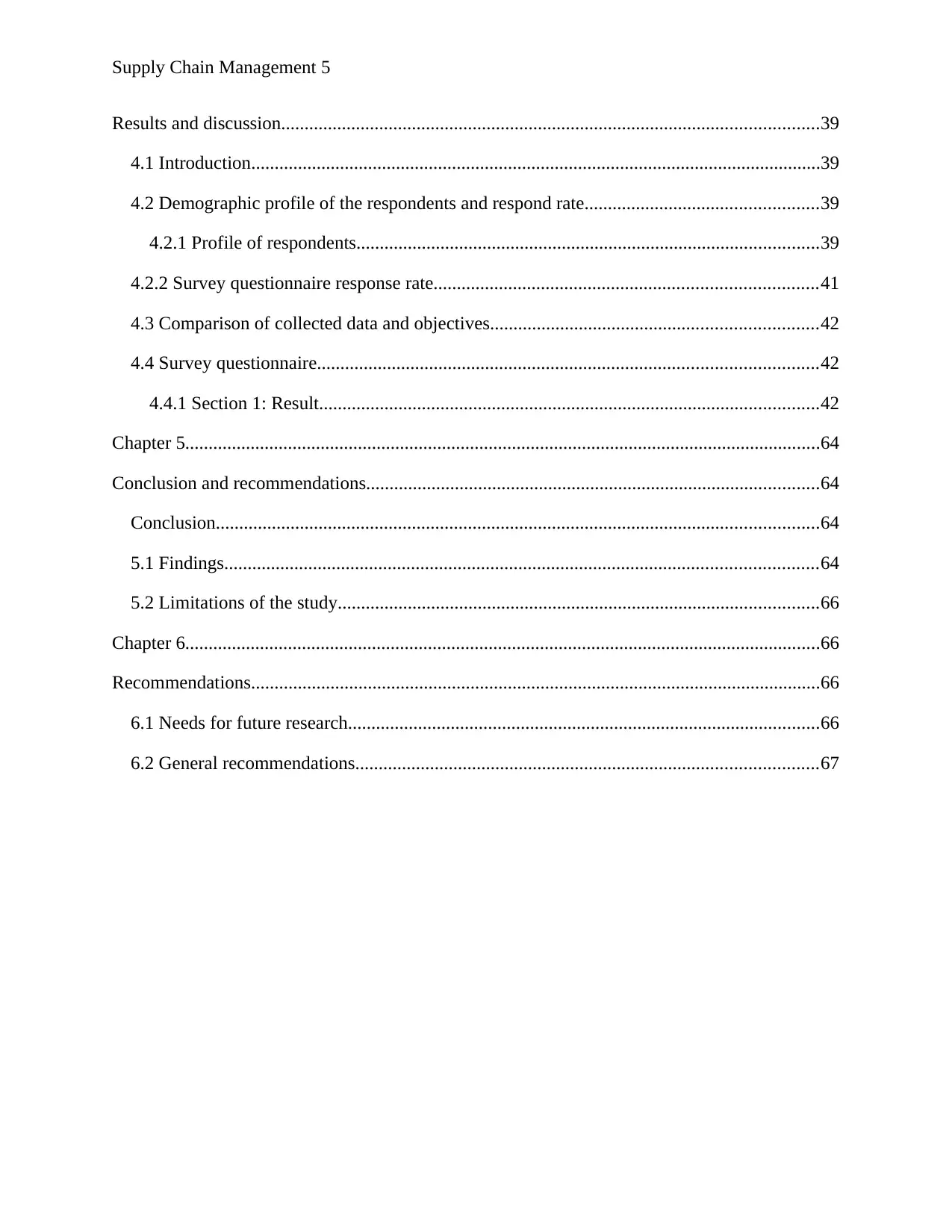
Supply Chain Management 5
Results and discussion...................................................................................................................39
4.1 Introduction..........................................................................................................................39
4.2 Demographic profile of the respondents and respond rate..................................................39
4.2.1 Profile of respondents...................................................................................................39
4.2.2 Survey questionnaire response rate..................................................................................41
4.3 Comparison of collected data and objectives......................................................................42
4.4 Survey questionnaire...........................................................................................................42
4.4.1 Section 1: Result...........................................................................................................42
Chapter 5........................................................................................................................................64
Conclusion and recommendations.................................................................................................64
Conclusion.................................................................................................................................64
5.1 Findings...............................................................................................................................64
5.2 Limitations of the study.......................................................................................................66
Chapter 6........................................................................................................................................66
Recommendations..........................................................................................................................66
6.1 Needs for future research.....................................................................................................66
6.2 General recommendations...................................................................................................67
Results and discussion...................................................................................................................39
4.1 Introduction..........................................................................................................................39
4.2 Demographic profile of the respondents and respond rate..................................................39
4.2.1 Profile of respondents...................................................................................................39
4.2.2 Survey questionnaire response rate..................................................................................41
4.3 Comparison of collected data and objectives......................................................................42
4.4 Survey questionnaire...........................................................................................................42
4.4.1 Section 1: Result...........................................................................................................42
Chapter 5........................................................................................................................................64
Conclusion and recommendations.................................................................................................64
Conclusion.................................................................................................................................64
5.1 Findings...............................................................................................................................64
5.2 Limitations of the study.......................................................................................................66
Chapter 6........................................................................................................................................66
Recommendations..........................................................................................................................66
6.1 Needs for future research.....................................................................................................66
6.2 General recommendations...................................................................................................67
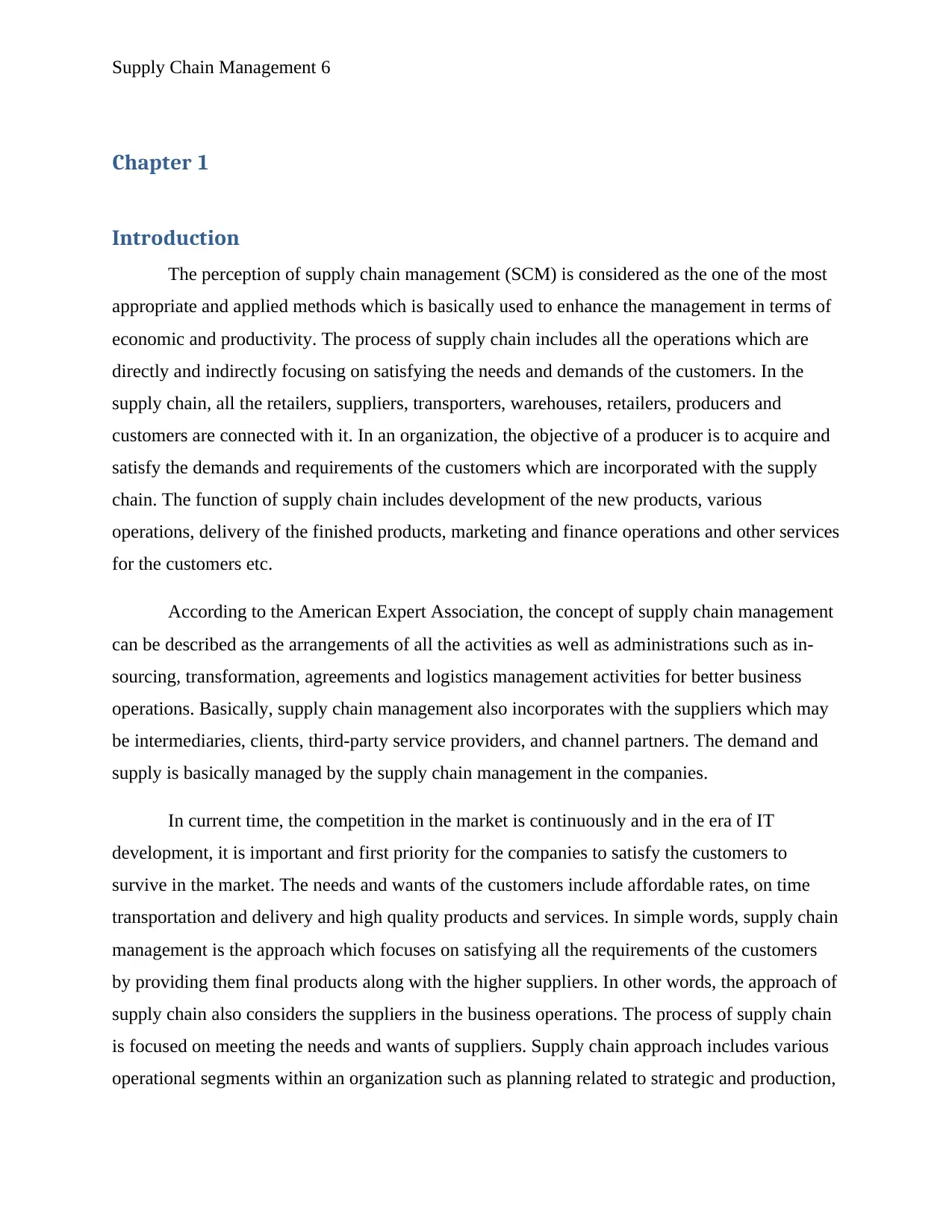
Supply Chain Management 6
Chapter 1
Introduction
The perception of supply chain management (SCM) is considered as the one of the most
appropriate and applied methods which is basically used to enhance the management in terms of
economic and productivity. The process of supply chain includes all the operations which are
directly and indirectly focusing on satisfying the needs and demands of the customers. In the
supply chain, all the retailers, suppliers, transporters, warehouses, retailers, producers and
customers are connected with it. In an organization, the objective of a producer is to acquire and
satisfy the demands and requirements of the customers which are incorporated with the supply
chain. The function of supply chain includes development of the new products, various
operations, delivery of the finished products, marketing and finance operations and other services
for the customers etc.
According to the American Expert Association, the concept of supply chain management
can be described as the arrangements of all the activities as well as administrations such as in-
sourcing, transformation, agreements and logistics management activities for better business
operations. Basically, supply chain management also incorporates with the suppliers which may
be intermediaries, clients, third-party service providers, and channel partners. The demand and
supply is basically managed by the supply chain management in the companies.
In current time, the competition in the market is continuously and in the era of IT
development, it is important and first priority for the companies to satisfy the customers to
survive in the market. The needs and wants of the customers include affordable rates, on time
transportation and delivery and high quality products and services. In simple words, supply chain
management is the approach which focuses on satisfying all the requirements of the customers
by providing them final products along with the higher suppliers. In other words, the approach of
supply chain also considers the suppliers in the business operations. The process of supply chain
is focused on meeting the needs and wants of suppliers. Supply chain approach includes various
operational segments within an organization such as planning related to strategic and production,
Chapter 1
Introduction
The perception of supply chain management (SCM) is considered as the one of the most
appropriate and applied methods which is basically used to enhance the management in terms of
economic and productivity. The process of supply chain includes all the operations which are
directly and indirectly focusing on satisfying the needs and demands of the customers. In the
supply chain, all the retailers, suppliers, transporters, warehouses, retailers, producers and
customers are connected with it. In an organization, the objective of a producer is to acquire and
satisfy the demands and requirements of the customers which are incorporated with the supply
chain. The function of supply chain includes development of the new products, various
operations, delivery of the finished products, marketing and finance operations and other services
for the customers etc.
According to the American Expert Association, the concept of supply chain management
can be described as the arrangements of all the activities as well as administrations such as in-
sourcing, transformation, agreements and logistics management activities for better business
operations. Basically, supply chain management also incorporates with the suppliers which may
be intermediaries, clients, third-party service providers, and channel partners. The demand and
supply is basically managed by the supply chain management in the companies.
In current time, the competition in the market is continuously and in the era of IT
development, it is important and first priority for the companies to satisfy the customers to
survive in the market. The needs and wants of the customers include affordable rates, on time
transportation and delivery and high quality products and services. In simple words, supply chain
management is the approach which focuses on satisfying all the requirements of the customers
by providing them final products along with the higher suppliers. In other words, the approach of
supply chain also considers the suppliers in the business operations. The process of supply chain
is focused on meeting the needs and wants of suppliers. Supply chain approach includes various
operational segments within an organization such as planning related to strategic and production,
⊘ This is a preview!⊘
Do you want full access?
Subscribe today to unlock all pages.

Trusted by 1+ million students worldwide
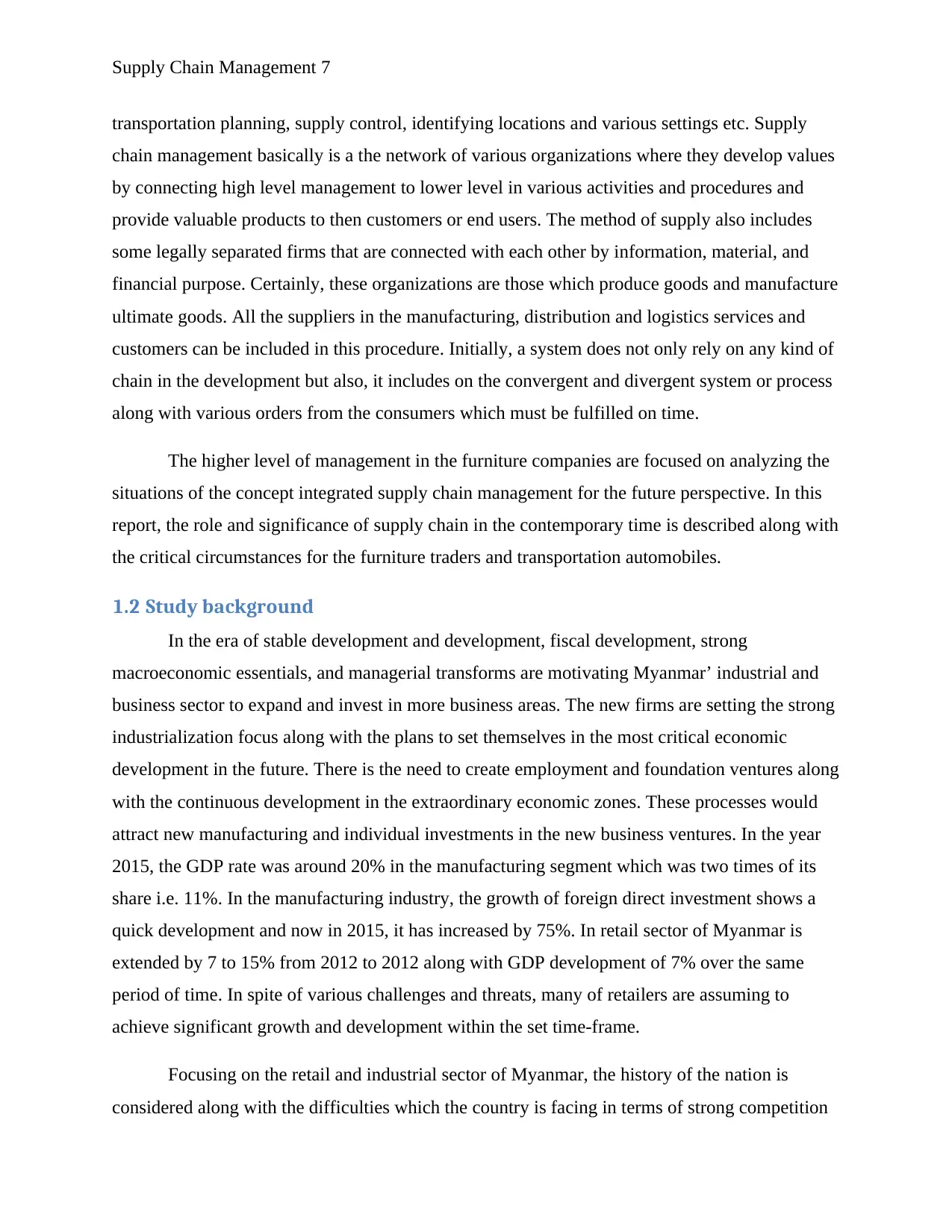
Supply Chain Management 7
transportation planning, supply control, identifying locations and various settings etc. Supply
chain management basically is a the network of various organizations where they develop values
by connecting high level management to lower level in various activities and procedures and
provide valuable products to then customers or end users. The method of supply also includes
some legally separated firms that are connected with each other by information, material, and
financial purpose. Certainly, these organizations are those which produce goods and manufacture
ultimate goods. All the suppliers in the manufacturing, distribution and logistics services and
customers can be included in this procedure. Initially, a system does not only rely on any kind of
chain in the development but also, it includes on the convergent and divergent system or process
along with various orders from the consumers which must be fulfilled on time.
The higher level of management in the furniture companies are focused on analyzing the
situations of the concept integrated supply chain management for the future perspective. In this
report, the role and significance of supply chain in the contemporary time is described along with
the critical circumstances for the furniture traders and transportation automobiles.
1.2 Study background
In the era of stable development and development, fiscal development, strong
macroeconomic essentials, and managerial transforms are motivating Myanmar’ industrial and
business sector to expand and invest in more business areas. The new firms are setting the strong
industrialization focus along with the plans to set themselves in the most critical economic
development in the future. There is the need to create employment and foundation ventures along
with the continuous development in the extraordinary economic zones. These processes would
attract new manufacturing and individual investments in the new business ventures. In the year
2015, the GDP rate was around 20% in the manufacturing segment which was two times of its
share i.e. 11%. In the manufacturing industry, the growth of foreign direct investment shows a
quick development and now in 2015, it has increased by 75%. In retail sector of Myanmar is
extended by 7 to 15% from 2012 to 2012 along with GDP development of 7% over the same
period of time. In spite of various challenges and threats, many of retailers are assuming to
achieve significant growth and development within the set time-frame.
Focusing on the retail and industrial sector of Myanmar, the history of the nation is
considered along with the difficulties which the country is facing in terms of strong competition
transportation planning, supply control, identifying locations and various settings etc. Supply
chain management basically is a the network of various organizations where they develop values
by connecting high level management to lower level in various activities and procedures and
provide valuable products to then customers or end users. The method of supply also includes
some legally separated firms that are connected with each other by information, material, and
financial purpose. Certainly, these organizations are those which produce goods and manufacture
ultimate goods. All the suppliers in the manufacturing, distribution and logistics services and
customers can be included in this procedure. Initially, a system does not only rely on any kind of
chain in the development but also, it includes on the convergent and divergent system or process
along with various orders from the consumers which must be fulfilled on time.
The higher level of management in the furniture companies are focused on analyzing the
situations of the concept integrated supply chain management for the future perspective. In this
report, the role and significance of supply chain in the contemporary time is described along with
the critical circumstances for the furniture traders and transportation automobiles.
1.2 Study background
In the era of stable development and development, fiscal development, strong
macroeconomic essentials, and managerial transforms are motivating Myanmar’ industrial and
business sector to expand and invest in more business areas. The new firms are setting the strong
industrialization focus along with the plans to set themselves in the most critical economic
development in the future. There is the need to create employment and foundation ventures along
with the continuous development in the extraordinary economic zones. These processes would
attract new manufacturing and individual investments in the new business ventures. In the year
2015, the GDP rate was around 20% in the manufacturing segment which was two times of its
share i.e. 11%. In the manufacturing industry, the growth of foreign direct investment shows a
quick development and now in 2015, it has increased by 75%. In retail sector of Myanmar is
extended by 7 to 15% from 2012 to 2012 along with GDP development of 7% over the same
period of time. In spite of various challenges and threats, many of retailers are assuming to
achieve significant growth and development within the set time-frame.
Focusing on the retail and industrial sector of Myanmar, the history of the nation is
considered along with the difficulties which the country is facing in terms of strong competition
Paraphrase This Document
Need a fresh take? Get an instant paraphrase of this document with our AI Paraphraser
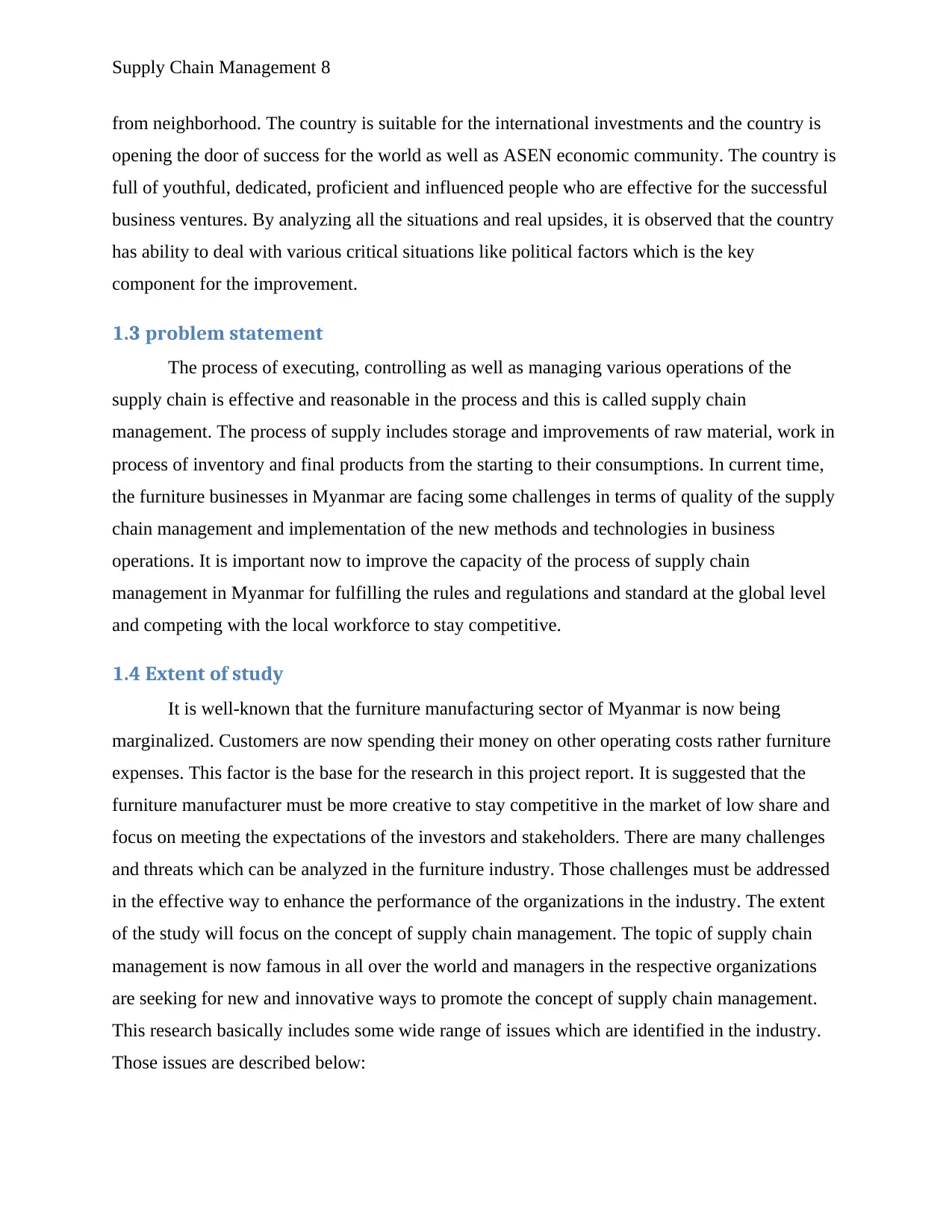
Supply Chain Management 8
from neighborhood. The country is suitable for the international investments and the country is
opening the door of success for the world as well as ASEN economic community. The country is
full of youthful, dedicated, proficient and influenced people who are effective for the successful
business ventures. By analyzing all the situations and real upsides, it is observed that the country
has ability to deal with various critical situations like political factors which is the key
component for the improvement.
1.3 problem statement
The process of executing, controlling as well as managing various operations of the
supply chain is effective and reasonable in the process and this is called supply chain
management. The process of supply includes storage and improvements of raw material, work in
process of inventory and final products from the starting to their consumptions. In current time,
the furniture businesses in Myanmar are facing some challenges in terms of quality of the supply
chain management and implementation of the new methods and technologies in business
operations. It is important now to improve the capacity of the process of supply chain
management in Myanmar for fulfilling the rules and regulations and standard at the global level
and competing with the local workforce to stay competitive.
1.4 Extent of study
It is well-known that the furniture manufacturing sector of Myanmar is now being
marginalized. Customers are now spending their money on other operating costs rather furniture
expenses. This factor is the base for the research in this project report. It is suggested that the
furniture manufacturer must be more creative to stay competitive in the market of low share and
focus on meeting the expectations of the investors and stakeholders. There are many challenges
and threats which can be analyzed in the furniture industry. Those challenges must be addressed
in the effective way to enhance the performance of the organizations in the industry. The extent
of the study will focus on the concept of supply chain management. The topic of supply chain
management is now famous in all over the world and managers in the respective organizations
are seeking for new and innovative ways to promote the concept of supply chain management.
This research basically includes some wide range of issues which are identified in the industry.
Those issues are described below:
from neighborhood. The country is suitable for the international investments and the country is
opening the door of success for the world as well as ASEN economic community. The country is
full of youthful, dedicated, proficient and influenced people who are effective for the successful
business ventures. By analyzing all the situations and real upsides, it is observed that the country
has ability to deal with various critical situations like political factors which is the key
component for the improvement.
1.3 problem statement
The process of executing, controlling as well as managing various operations of the
supply chain is effective and reasonable in the process and this is called supply chain
management. The process of supply includes storage and improvements of raw material, work in
process of inventory and final products from the starting to their consumptions. In current time,
the furniture businesses in Myanmar are facing some challenges in terms of quality of the supply
chain management and implementation of the new methods and technologies in business
operations. It is important now to improve the capacity of the process of supply chain
management in Myanmar for fulfilling the rules and regulations and standard at the global level
and competing with the local workforce to stay competitive.
1.4 Extent of study
It is well-known that the furniture manufacturing sector of Myanmar is now being
marginalized. Customers are now spending their money on other operating costs rather furniture
expenses. This factor is the base for the research in this project report. It is suggested that the
furniture manufacturer must be more creative to stay competitive in the market of low share and
focus on meeting the expectations of the investors and stakeholders. There are many challenges
and threats which can be analyzed in the furniture industry. Those challenges must be addressed
in the effective way to enhance the performance of the organizations in the industry. The extent
of the study will focus on the concept of supply chain management. The topic of supply chain
management is now famous in all over the world and managers in the respective organizations
are seeking for new and innovative ways to promote the concept of supply chain management.
This research basically includes some wide range of issues which are identified in the industry.
Those issues are described below:
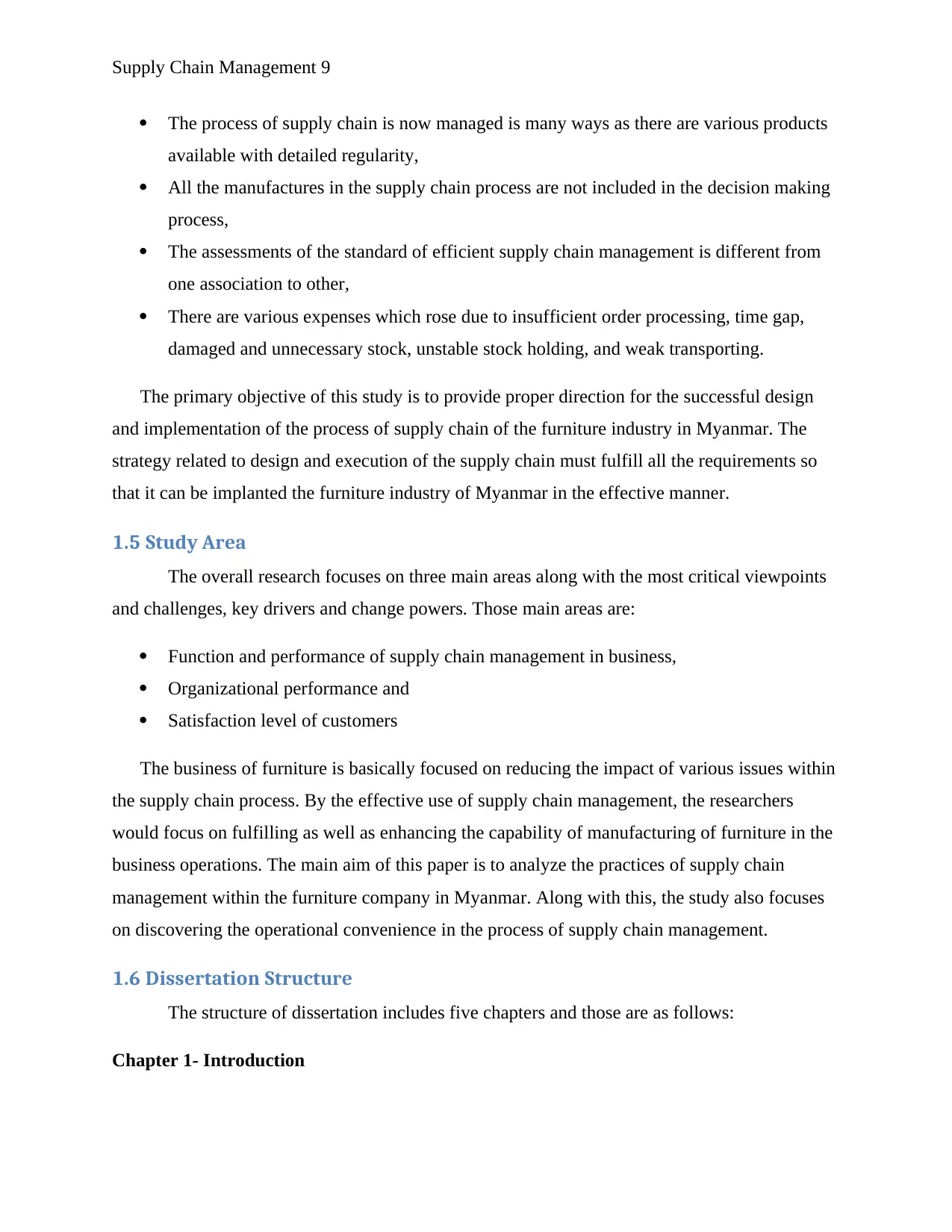
Supply Chain Management 9
The process of supply chain is now managed is many ways as there are various products
available with detailed regularity,
All the manufactures in the supply chain process are not included in the decision making
process,
The assessments of the standard of efficient supply chain management is different from
one association to other,
There are various expenses which rose due to insufficient order processing, time gap,
damaged and unnecessary stock, unstable stock holding, and weak transporting.
The primary objective of this study is to provide proper direction for the successful design
and implementation of the process of supply chain of the furniture industry in Myanmar. The
strategy related to design and execution of the supply chain must fulfill all the requirements so
that it can be implanted the furniture industry of Myanmar in the effective manner.
1.5 Study Area
The overall research focuses on three main areas along with the most critical viewpoints
and challenges, key drivers and change powers. Those main areas are:
Function and performance of supply chain management in business,
Organizational performance and
Satisfaction level of customers
The business of furniture is basically focused on reducing the impact of various issues within
the supply chain process. By the effective use of supply chain management, the researchers
would focus on fulfilling as well as enhancing the capability of manufacturing of furniture in the
business operations. The main aim of this paper is to analyze the practices of supply chain
management within the furniture company in Myanmar. Along with this, the study also focuses
on discovering the operational convenience in the process of supply chain management.
1.6 Dissertation Structure
The structure of dissertation includes five chapters and those are as follows:
Chapter 1- Introduction
The process of supply chain is now managed is many ways as there are various products
available with detailed regularity,
All the manufactures in the supply chain process are not included in the decision making
process,
The assessments of the standard of efficient supply chain management is different from
one association to other,
There are various expenses which rose due to insufficient order processing, time gap,
damaged and unnecessary stock, unstable stock holding, and weak transporting.
The primary objective of this study is to provide proper direction for the successful design
and implementation of the process of supply chain of the furniture industry in Myanmar. The
strategy related to design and execution of the supply chain must fulfill all the requirements so
that it can be implanted the furniture industry of Myanmar in the effective manner.
1.5 Study Area
The overall research focuses on three main areas along with the most critical viewpoints
and challenges, key drivers and change powers. Those main areas are:
Function and performance of supply chain management in business,
Organizational performance and
Satisfaction level of customers
The business of furniture is basically focused on reducing the impact of various issues within
the supply chain process. By the effective use of supply chain management, the researchers
would focus on fulfilling as well as enhancing the capability of manufacturing of furniture in the
business operations. The main aim of this paper is to analyze the practices of supply chain
management within the furniture company in Myanmar. Along with this, the study also focuses
on discovering the operational convenience in the process of supply chain management.
1.6 Dissertation Structure
The structure of dissertation includes five chapters and those are as follows:
Chapter 1- Introduction
⊘ This is a preview!⊘
Do you want full access?
Subscribe today to unlock all pages.

Trusted by 1+ million students worldwide
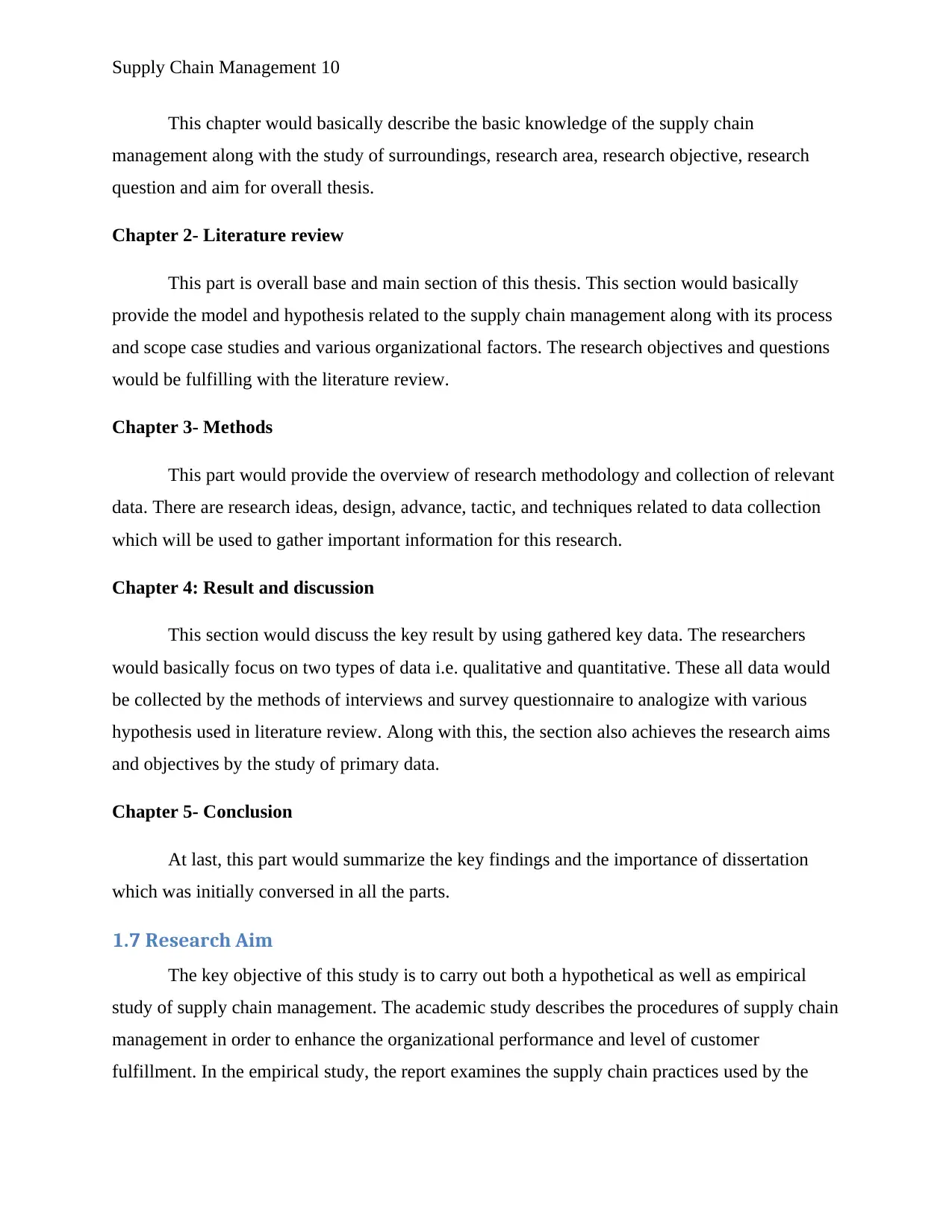
Supply Chain Management 10
This chapter would basically describe the basic knowledge of the supply chain
management along with the study of surroundings, research area, research objective, research
question and aim for overall thesis.
Chapter 2- Literature review
This part is overall base and main section of this thesis. This section would basically
provide the model and hypothesis related to the supply chain management along with its process
and scope case studies and various organizational factors. The research objectives and questions
would be fulfilling with the literature review.
Chapter 3- Methods
This part would provide the overview of research methodology and collection of relevant
data. There are research ideas, design, advance, tactic, and techniques related to data collection
which will be used to gather important information for this research.
Chapter 4: Result and discussion
This section would discuss the key result by using gathered key data. The researchers
would basically focus on two types of data i.e. qualitative and quantitative. These all data would
be collected by the methods of interviews and survey questionnaire to analogize with various
hypothesis used in literature review. Along with this, the section also achieves the research aims
and objectives by the study of primary data.
Chapter 5- Conclusion
At last, this part would summarize the key findings and the importance of dissertation
which was initially conversed in all the parts.
1.7 Research Aim
The key objective of this study is to carry out both a hypothetical as well as empirical
study of supply chain management. The academic study describes the procedures of supply chain
management in order to enhance the organizational performance and level of customer
fulfillment. In the empirical study, the report examines the supply chain practices used by the
This chapter would basically describe the basic knowledge of the supply chain
management along with the study of surroundings, research area, research objective, research
question and aim for overall thesis.
Chapter 2- Literature review
This part is overall base and main section of this thesis. This section would basically
provide the model and hypothesis related to the supply chain management along with its process
and scope case studies and various organizational factors. The research objectives and questions
would be fulfilling with the literature review.
Chapter 3- Methods
This part would provide the overview of research methodology and collection of relevant
data. There are research ideas, design, advance, tactic, and techniques related to data collection
which will be used to gather important information for this research.
Chapter 4: Result and discussion
This section would discuss the key result by using gathered key data. The researchers
would basically focus on two types of data i.e. qualitative and quantitative. These all data would
be collected by the methods of interviews and survey questionnaire to analogize with various
hypothesis used in literature review. Along with this, the section also achieves the research aims
and objectives by the study of primary data.
Chapter 5- Conclusion
At last, this part would summarize the key findings and the importance of dissertation
which was initially conversed in all the parts.
1.7 Research Aim
The key objective of this study is to carry out both a hypothetical as well as empirical
study of supply chain management. The academic study describes the procedures of supply chain
management in order to enhance the organizational performance and level of customer
fulfillment. In the empirical study, the report examines the supply chain practices used by the
Paraphrase This Document
Need a fresh take? Get an instant paraphrase of this document with our AI Paraphraser
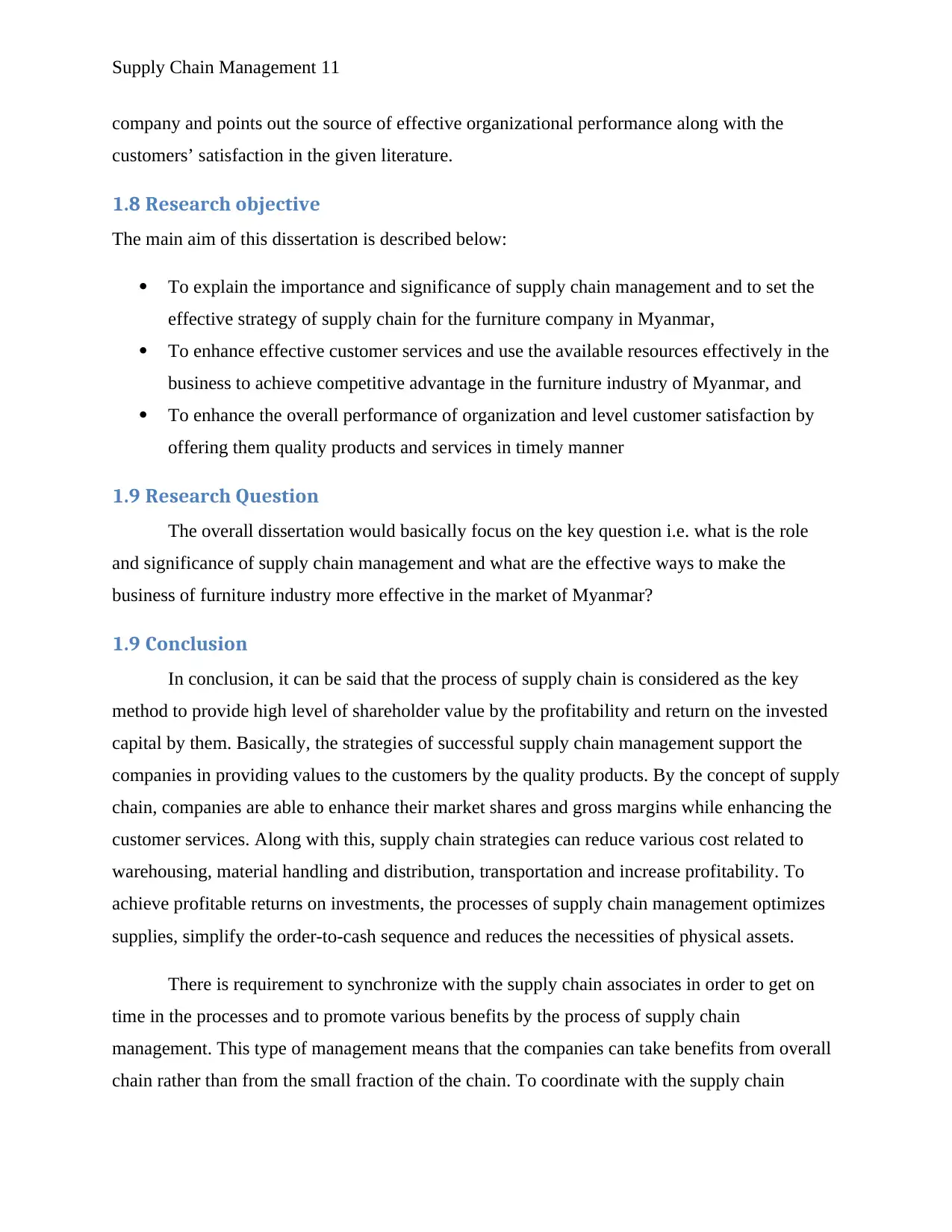
Supply Chain Management 11
company and points out the source of effective organizational performance along with the
customers’ satisfaction in the given literature.
1.8 Research objective
The main aim of this dissertation is described below:
To explain the importance and significance of supply chain management and to set the
effective strategy of supply chain for the furniture company in Myanmar,
To enhance effective customer services and use the available resources effectively in the
business to achieve competitive advantage in the furniture industry of Myanmar, and
To enhance the overall performance of organization and level customer satisfaction by
offering them quality products and services in timely manner
1.9 Research Question
The overall dissertation would basically focus on the key question i.e. what is the role
and significance of supply chain management and what are the effective ways to make the
business of furniture industry more effective in the market of Myanmar?
1.9 Conclusion
In conclusion, it can be said that the process of supply chain is considered as the key
method to provide high level of shareholder value by the profitability and return on the invested
capital by them. Basically, the strategies of successful supply chain management support the
companies in providing values to the customers by the quality products. By the concept of supply
chain, companies are able to enhance their market shares and gross margins while enhancing the
customer services. Along with this, supply chain strategies can reduce various cost related to
warehousing, material handling and distribution, transportation and increase profitability. To
achieve profitable returns on investments, the processes of supply chain management optimizes
supplies, simplify the order-to-cash sequence and reduces the necessities of physical assets.
There is requirement to synchronize with the supply chain associates in order to get on
time in the processes and to promote various benefits by the process of supply chain
management. This type of management means that the companies can take benefits from overall
chain rather than from the small fraction of the chain. To coordinate with the supply chain
company and points out the source of effective organizational performance along with the
customers’ satisfaction in the given literature.
1.8 Research objective
The main aim of this dissertation is described below:
To explain the importance and significance of supply chain management and to set the
effective strategy of supply chain for the furniture company in Myanmar,
To enhance effective customer services and use the available resources effectively in the
business to achieve competitive advantage in the furniture industry of Myanmar, and
To enhance the overall performance of organization and level customer satisfaction by
offering them quality products and services in timely manner
1.9 Research Question
The overall dissertation would basically focus on the key question i.e. what is the role
and significance of supply chain management and what are the effective ways to make the
business of furniture industry more effective in the market of Myanmar?
1.9 Conclusion
In conclusion, it can be said that the process of supply chain is considered as the key
method to provide high level of shareholder value by the profitability and return on the invested
capital by them. Basically, the strategies of successful supply chain management support the
companies in providing values to the customers by the quality products. By the concept of supply
chain, companies are able to enhance their market shares and gross margins while enhancing the
customer services. Along with this, supply chain strategies can reduce various cost related to
warehousing, material handling and distribution, transportation and increase profitability. To
achieve profitable returns on investments, the processes of supply chain management optimizes
supplies, simplify the order-to-cash sequence and reduces the necessities of physical assets.
There is requirement to synchronize with the supply chain associates in order to get on
time in the processes and to promote various benefits by the process of supply chain
management. This type of management means that the companies can take benefits from overall
chain rather than from the small fraction of the chain. To coordinate with the supply chain
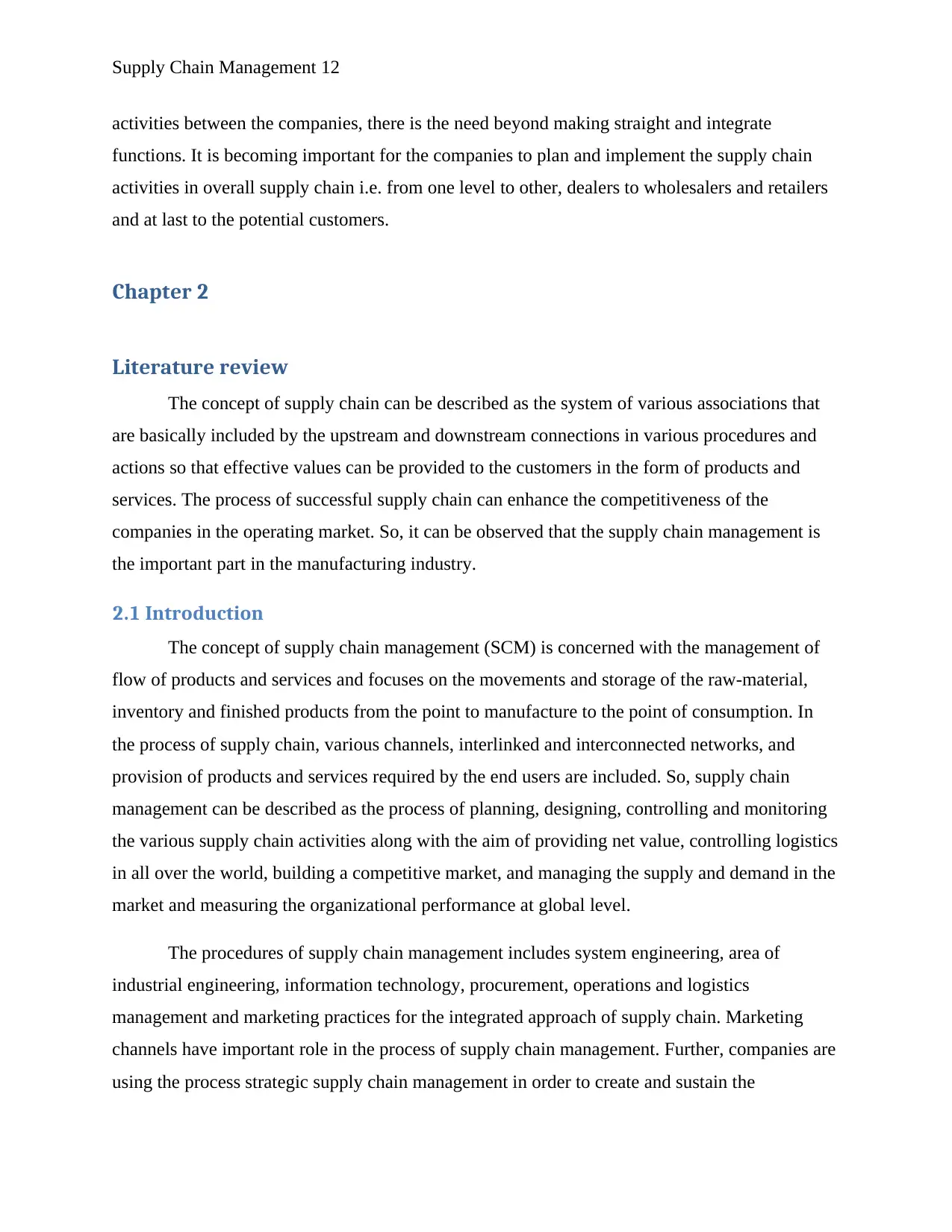
Supply Chain Management 12
activities between the companies, there is the need beyond making straight and integrate
functions. It is becoming important for the companies to plan and implement the supply chain
activities in overall supply chain i.e. from one level to other, dealers to wholesalers and retailers
and at last to the potential customers.
Chapter 2
Literature review
The concept of supply chain can be described as the system of various associations that
are basically included by the upstream and downstream connections in various procedures and
actions so that effective values can be provided to the customers in the form of products and
services. The process of successful supply chain can enhance the competitiveness of the
companies in the operating market. So, it can be observed that the supply chain management is
the important part in the manufacturing industry.
2.1 Introduction
The concept of supply chain management (SCM) is concerned with the management of
flow of products and services and focuses on the movements and storage of the raw-material,
inventory and finished products from the point to manufacture to the point of consumption. In
the process of supply chain, various channels, interlinked and interconnected networks, and
provision of products and services required by the end users are included. So, supply chain
management can be described as the process of planning, designing, controlling and monitoring
the various supply chain activities along with the aim of providing net value, controlling logistics
in all over the world, building a competitive market, and managing the supply and demand in the
market and measuring the organizational performance at global level.
The procedures of supply chain management includes system engineering, area of
industrial engineering, information technology, procurement, operations and logistics
management and marketing practices for the integrated approach of supply chain. Marketing
channels have important role in the process of supply chain management. Further, companies are
using the process strategic supply chain management in order to create and sustain the
activities between the companies, there is the need beyond making straight and integrate
functions. It is becoming important for the companies to plan and implement the supply chain
activities in overall supply chain i.e. from one level to other, dealers to wholesalers and retailers
and at last to the potential customers.
Chapter 2
Literature review
The concept of supply chain can be described as the system of various associations that
are basically included by the upstream and downstream connections in various procedures and
actions so that effective values can be provided to the customers in the form of products and
services. The process of successful supply chain can enhance the competitiveness of the
companies in the operating market. So, it can be observed that the supply chain management is
the important part in the manufacturing industry.
2.1 Introduction
The concept of supply chain management (SCM) is concerned with the management of
flow of products and services and focuses on the movements and storage of the raw-material,
inventory and finished products from the point to manufacture to the point of consumption. In
the process of supply chain, various channels, interlinked and interconnected networks, and
provision of products and services required by the end users are included. So, supply chain
management can be described as the process of planning, designing, controlling and monitoring
the various supply chain activities along with the aim of providing net value, controlling logistics
in all over the world, building a competitive market, and managing the supply and demand in the
market and measuring the organizational performance at global level.
The procedures of supply chain management includes system engineering, area of
industrial engineering, information technology, procurement, operations and logistics
management and marketing practices for the integrated approach of supply chain. Marketing
channels have important role in the process of supply chain management. Further, companies are
using the process strategic supply chain management in order to create and sustain the
⊘ This is a preview!⊘
Do you want full access?
Subscribe today to unlock all pages.

Trusted by 1+ million students worldwide
1 out of 71
Related Documents
Your All-in-One AI-Powered Toolkit for Academic Success.
+13062052269
info@desklib.com
Available 24*7 on WhatsApp / Email
![[object Object]](/_next/static/media/star-bottom.7253800d.svg)
Unlock your academic potential
Copyright © 2020–2025 A2Z Services. All Rights Reserved. Developed and managed by ZUCOL.





